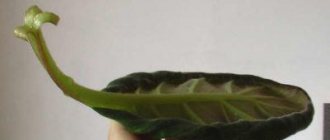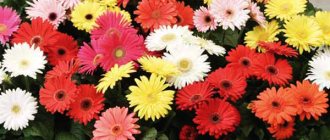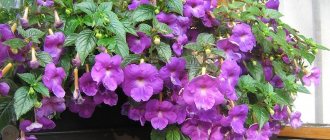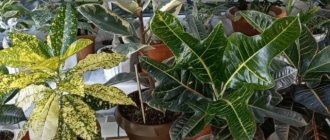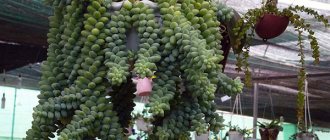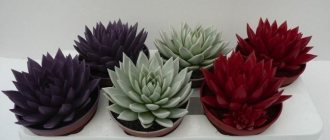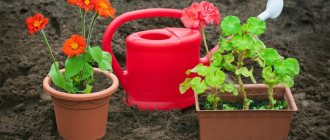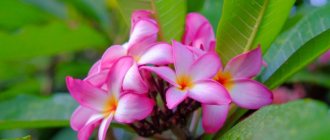This article describes the structure of the reproductive organ of a flower - the pistil and stamen. You will learn how this process occurs in plants.
Flowers are truly unique plants. They not only attract attention with their appearance, but are also a source of useful substances. Everything about them is unusual, including their method of reproduction. From school biology lessons, you can remember the names of the main “genital organs” of plants – pistil and stamen. But what is it, and what functions do these parts of plant crops perform?
Read an article on biology riddles . The information contained in it will help you prepare for the quiz lesson on this subject.
If you need to help your child complete homework on this topic, then this article will help you. It contains a lot of useful information that will help you remember the material you covered. If the student completes the task himself, then the article will help to find the correct answer to the question and formulate a thought. Read on.
Flower - pistil and stamen: the main parts in the reproductive organs
A typical inflorescence of a flower
The upper flowering part of the plant, which we are accustomed to admiring, is nothing more than the reproductive organ of plants. A flower with a pistil and stamen is the reproductive system of representatives of the world of flora, its main parts.
It grows on shoots, of which there may be several on plants. This form of flower formation is called an inflorescence. They are divided into 2 groups - simple and complex.
- Simple inflorescences . On their surface are all the flowers located on the main axis of the shoot.
- Complex inflorescences. They are characterized by the presence not of individual flowers, but of several small branched inflorescences on the main axis of the shoot. They reflect the basic structure of the flower.
Typically, inflorescences are formed by small flowers, while large flowers grow separately. But it is the small flowers, collected together, that form the structural inflorescence and give the strong aroma of nectar. This smell attracts insects, which subsequently transfer pollen from one crop to another, pollinating it.
Worth knowing: More grains and fruits are formed in inflorescences than in individual flowers. Thanks to this, the reproductive capacity of crops increases, which makes their reproduction process more efficient and intensive.
Some inflorescences look like one large flower. This is the result of a long process of evolution. A similar phenomenon can be observed in sunflower, chamomile, viburnum, cornflower and many other plants. It is the large and bright petals that attract the attention of insects that collect nectar, so they are able to pollinate several plants at once in one approach.
What should I root cuttings in?
Regular pots work well for rooting stem cuttings. However, filling containers is slightly different from how it is done for seed propagation. To root the cutting, you also first need to create a drainage layer in the pot. It is made from shards, pebbles or expanded clay - any material that does not retain water and allows water to pass through well. After this, a soil mixture of peat and deciduous soil with sand is applied to the drainage as the next layer. And a layer of clean coarse sand is placed on the very top. In addition to pots, you will also need glass jars. They are necessary to cover the rooting cuttings. Glass jars are good because they maintain the necessary level of humidity for rooting, and at the same time light penetrates well through them. At the same time, it is undesirable to leave cuttings in direct sunlight. If they are allocated just such a place, then they will need to arrange shading for them.
The perianth consists of stamens, pistils, corolla, calyx: structural features of the flower, pattern
The perianth consists of stamens, pistils, corolla, calyx.
Flowers have their own structural features, which are in many ways the same and different at the same time. But absolutely all plants have the following structural components - structural features of the flower (above in the figure):
- Pedicel . This name was given to the last node located on the stem of the plant.
- Receptacle . This is the place where the flower opens. It is a special organ like a frame. It is on this that the entire basic structure of the flower plant is located.
- Around the receptacle is the perianth . It performs, first of all, protective functions. In other words, it protects the organs of the reproductive system of the crop - the pistil and stamen.
Interesting: The perianth attracts insects to the flower. Some perianths are capable of forming corollas. This is the name given to the collection of petals on the inside of a flower. They have a bright and rich color, and also serve to attract insects that collect pollen.
And all this complex structure of the flower is intended for only one thing - to perform the reproductive function. The stamen, pistil, corollas and calyx in fruit and berry plants play an even more important role. They are responsible for the formation of the ovary, from which over time a full-fledged fruit is formed.
Structure and functions of the stamen: features, anther, photo
Structure and functions of the stamen
As mentioned above, the stamen is formed in two parts - the anther and the filament. Features of the structure and function of the stamen (look at the photo above):
- The anther has two more parts.
- They are specific sacs where pollen accumulates. And it is contained in special nests that are attached to the anther sacs.
- Each flower may have one or more stamens. And in some plant varieties, the number of male sections of the reproductive system can even reach several thousand.
Interesting : The collection of stamens has a scientific name - androecium. It can be circular or spiral - it all depends on how the parts of the reproductive section are located.
In some cases, the stamens are even able to grow together - partially or completely. For example, in pumpkin crops the fusion of the staminate parts is predominantly total. Also, sometimes the pistil fuses with the stamen, forming a new, special organ - the column. A similar process can be observed when growing orchids.
What is the structure of the pistil: features, role of the style and ovary, photo
The structure of the pistil: features, the role of the style and the ovary.
The formation of the pistil occurs when one or more carpels grow together. Its structure is simple (pictured above). It contains seed primordia and a special tract that contains ripening pollen until the moment of fertilization.
The pestle has its own structure. It is formed in three parts, each of which performs its assigned functions. Below you will find the features of this part of the plant, as well as the role of the style and ovary. The main structural units of the female reproductive organ of a plant:
- Ovary . It is the base of the pistil and is located in its lower part. After the fertilization process, further maturation and development of seeds occurs in this area. more about what an ovary is in a plant in another article on our website.
- Column . This is the sterile part of the pistil, which originates from the ovary and gradually flows into the stigma. Its main role is frame, supporting. The columns of the pistils are divided into open, closed and semi-closed. It all depends on how pronounced the process of fusion of the stylodium is.
- Stigma . This is a separate organ whose main task is to produce pollen. To put it simply, he catches it and delivers it to the pestle.
This is how the female organ of the reproductive system of a flower, the pistil, works. It is not difficult to distinguish it from a stamen. The pistil is located at the very bottom, at the base of the flower petals, while the stamens can be located on the sides, or located at the very top, at the edges of the petals.
General rules for propagation by stem cuttings
You should choose for the cutting a young, strong and well-developed apical shoot with several leaves, without the slightest flaws or traces of parasites. If the plant has suffered from a lack or excess of water, you should not take cuttings from this plant, as the result can be a weak plant.
The cut must be precise and clean and pass over a leaf or pair of leaves without leaving a bare stump. The length of the cutting depends on the distance between the nodes from which the leaves grow. If the stem has short internodes and a large number of leaves, like Tradescantia, then 5 - 8 cm is enough. For large plants with long internodes (rubber ficus), take a cutting 10 to 15 cm long.
Preparing the cutting is called pruning. First, cut the stem again, this time under a node or under the lower bud. This is where the roots will begin to develop. Remove the lower leaves from the cuttings, leaving only two or three large leaves or five small ones. On some cuttings, cut the leaf blade halfway to reduce water loss. You cannot trim hard and shiny leaves, such as those of rubber ficus, which are accustomed to a minimal amount of moisture.
If the stem is woody at the base, dip it in hormonal powder. Cuttings of some woody plants are better accepted if a fragment of the main branch or cuttings with a heel are left at the base. To do this, cut off a side shoot with a piece of bark, pulling it downwards. The bark fragment should be no more than 1-2 cm.
Plant the cuttings in individual pots or 3-5 pieces in a large pot. You should use a substrate special for young plants, light and well permeable to water. After planting, water with a spray bottle or watering can with a fine mesh. Place the cuttings in a mini-greenhouse or cover with plastic wrap. This is an ideal way to maintain a warm, humid atmosphere that is beneficial for rooting.
It is easiest to cut plants with soft stems at home: tradescantia, syngonium, coleus, pilea, balsam, geranium, ivy, etc. Large plants with strong stems are more difficult to cut. This operation should be performed from June to mid-September, as it will be easier for the cuttings to take root during the period of active growth. Palms and cycads cannot be propagated by cuttings, since they have only one growth point - the apical bud. Ferns that form tufts of leaves rather than stems are not amenable to cuttings. The same applies to annual plants whose stems die after flowering.
If the plant takes root easily, then you can use a regular substrate. You can add vermiculite or perlite to the substrate to add lightness. To avoid rotting of the cuttings, instead of soil, use calcined sand or a mixture of sand and peat in equal proportions. The soil should be free of pests and pathogens. Peat, which is part of the substrate for cuttings, has a healing effect; it creates an acidic environment unfavorable for the development of bacteria.
To prevent the cuttings from developing fungi, the cuttings and substrate can be sprayed with a 0.2% solution of foundationazole. The most common reason for the death of cuttings is their rotting, drying out, sunburn, and poor temperature conditions. Rooting stimulants are not able to eliminate the main causes of death of cuttings. They can only help some plants form roots faster. When purchasing growth stimulants, you should pay attention to the expiration date and carefully read the instructions for use and strictly follow them. An overdose of the drug is dangerous. Instead of enhancing rooting, premature aging and even death of the plant can be achieved. By stimulating the formation of roots, these substances cause delayed bud formation or slower shoot growth. Therefore, it is better to dip only the lower part of the cutting into the solution or powder. Do not immerse the entire cutting in the solution. If leaf cuttings are used, the use of root formation stimulants is undesirable. For cuttings that are difficult to root, stimulants may be the only hope for rooting. Therefore, it is possible and necessary to apply them, but at the same time treat them as one of the conditions for success, but far from being the most important thing, and follow the basic rules of working with them. If you do not have growth stimulants, then you can do without them. Most indoor plants can take root without them.
Many plants can be taken from cuttings at any time of the year. However, the best results are obtained if the plant is actively growing or has just finished growing. For roses, the indicator that a shoot is ready for cuttings is flowering. For woody plants, cuttings should have fresh growth, but have already become lignified. Coniferous plants form roots better immediately after a period of cool winter dormancy... Each plant has its own optimal time for cuttings. But if it is possible in any season of the year to ensure that the plantings are heated from below to 20-25 degrees, then the time of year does not matter. If there are no such favorable conditions for cuttings, then it is better to postpone it to spring and summer.
The concept of monoecious and dioecious flowers: what is the formula of the pistil and stamen, an example of reproduction?
Cucumber flowers are monoecious.
It is worth noting that different plants may have different pistil and stamen formulas. Both staminate and pistillate flowers are often located on the same plant. Thanks to this, the crop becomes capable of self-pollination and does not need outside help. Representatives of the world of flora, which are characterized by this quality, are called monoecious . Examples of this group of crops include pumpkin and cucumbers .
But there is another category of plants, which is called dioecious . In this case, female and male individuals are located on different specimens of plant crops. Therefore, to ensure the pollination process, the participation of insects is necessary. Widely known representatives of this group are stinging nettle, willow, and aspen.
There is also the concept of asexual plants. We are talking about them when there are no organs of sexual reproduction on the surface of the culture.
The concept of monoecious and dioecious flowers
Below you will find an example of the propagation of dioecious plants. If everything is simple and clear with monoecious plant crops, then the peculiarities of reproduction of dioecious specimens cause some bewilderment. In fact, there is nothing supernatural in this process, but this process is really interesting. Let's look at a small example of how pollination occurs in dioecious plants.
Poplar is a dioecious plant
- Everyone knows a tree called poplar. This is also a typical representative of the category of dioecious plants.
- In the spring, male poplars begin to scatter pollen, and in the summer, female specimens of the plant spread white fluff. It is in this unusual and interesting way that this tree reproduces.
- Poplar fluff contains seeds that do not scatter and are not lost precisely thanks to the down threads. They are firmly attached to them and can easily fly away from the parent tree over considerable distances.
- The same unusual and interesting method of propagation is typical for dandelions.
Since dioecious plants require the participation of insects in the pollination process, the yield of fruit and berry crops and vegetables largely depends on how active wasps, bees, hornets , etc. The higher their activity, the better the harvest. And, therefore, the lower it is, the less chance there is for intensive and rich fruiting of individual garden and vegetable crops.
How to cut a cutting?
It is cut off from below under the eye. And the top is cut off above the eye. However, this rule does not apply to all colors. For example, to propagate carnations, cuttings are broken at the internodes. Another rule is that in order for the plant to grow and bloom faster, it is propagated by apical cuttings. It is suitable for growing fuchsia, geranium, and chrysanthemum. After cutting the cutting, but before planting it for rooting, it is advisable to remove one or two lower leaves. This will make planting it more convenient, and rooting will occur faster. Because the plant will not have to allocate resources to maintain life in the leaves and at the same time form the root system. This will make the rooting process easier for him. Moreover, large leaves can be cut in half. Thanks to this, they will evaporate less moisture from the surface of the sheet plate. By the way, not every cutting needs to be immediately sent for rooting. If you are going to propagate some succulent plants from leaf cuttings, they need to first lie in a dry, dark place for several days. After such preparation, processes are activated in the leaf that stimulate it to “fight for life” and take root faster.
Flower biorhythms - pistil and stamen: useful information about reproduction
Biorhythms of a flower
A flower is a living organism that also has its own biorhythms. It tends to be awake and in a state of sleep - just like humans, animals, etc. You can understand what phase a plant is in at the moment by the state of its petals. They close and open depending on the time of day. In addition, the type of flower crop also affects biorhythms.
A simple example of a flower clock:
- Chicory and salsify . These plants open at 3-4 o'clock in the morning and remain in this position almost until the evening.
- Poppies and rose hips wake up at 5 o'clock in the morning .
- Periwinkle, dandelion, bluebell . These plants begin to open at about 6 am .
- Marigolds and bindweeds . The period of their awakening and activity falls at 8 o'clock in the morning and lasts until the evening.
- Marigolds . These flowers open at 9 o'clock in the morning .
Starting from lunch until evening, the flowers gradually begin to wilt. This means that they close and enter the sleep phase. The specific time for the petals to completely close depends on the type of flower crop. For example:
- The wild carnation closes at about 1 am.
- The time when cactus flowers enter the sleep phase is 2 am.
- Dandelion begins to close at 3 am.
- The Greek woman closes her petals in the morning - at approximately 4 o'clock.
- The white water lily closes at 5 a.m., etc.
Each plant has its own special biorhythms. And they most directly influence the reproduction of culture. Here is some more interesting information about reproduction, pistils and stamens:
- Based on the above, in the world of flora there are girl plants and boy plants. They are bisexual and dioecious.
- In the first case, flowers are characterized by the process of self-pollination.
- But for the reproduction of dioecious crops, the help of insects is needed - wasps, bees, etc. They transfer male gametes to the female plant.
- This is the only way to ensure the pollination process for further plant propagation.
Now you know the structure of a flower and how plants reproduce. To consolidate the material, try using the pictures above to tell yourself about the process of plant propagation. Also watch the video below which goes into detail about this process.
